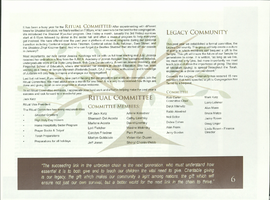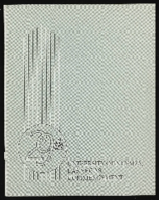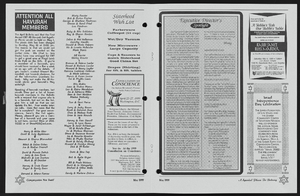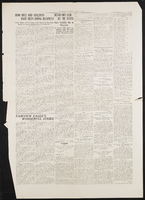Search the Special Collections and Archives Portal
Search Results

Contract, Instrument transferring interests in real and personal property, Las Vegas Land and Water Company, Audit No. 5351, June 1, 1954
Date
Archival Collection
Description
Release of all rights, licenses, leases, contracts, etc., of the Las Vegas Land and Water Company to the Las Vegas Valley Water District. Notarized by Louis Scholnick in Douglas County, Nebraska on June 3, 1954.
Text
Sands Hotel Public Relations Records
Identifier
Abstract
The Sands Hotel Public Relations Records document the history of the Las Vegas casino and hotel from 1952 to 1977. It is comprised primarily of photographs, mostly 8x10 black-and-white prints, color prints, and transparencies. Most were produced by the Las Vegas News Bureau. Also included are newspaper clippings, brochures, press releases, and inter-office memos relating to the advertising and promotion department. Materials also include reels of 16mm film of the Sands opening, various shows and events including Frank Sinatra and Dean Martin's "Summit Meeting" performances with the Rat Pack, and footage from various television productions filmed at the Sands.
Archival Collection

Annual report from Congregation Ner Tamid, 2013-2014
Date
Archival Collection
Description
Annual report from Congregation Ner Tamid, 2013-2014
Text

University of Nevada, Las Vegas (UNLV) 29th commencement program
Date
Archival Collection
Description
Commencement program from University of Nevada, Las Vegas Commencement Programs and Graduation Lists (UA-00115).
Text
Samuel Liddle General Store Records
Identifier
Abstract
The Samuel Liddle General Store Records (1885-1887) are comprised of order forms, inventories, and customer ledgers for Liddle's General Store in Leadville, Nevada. The store was created to provide services to residents and prospectors during a mining boom in White Pine County that lasted from 1887 to approximately 1890. The materials also consist of Liddle's General Store accounts, business correspondence, and transactions, such as wholesale purchases of general merchandise and mining supplies from vendors in Eureka, Nevada, San Francisco, California, and smaller nearby locations. An undated hand-drawn map of the townsite is also included.
Archival Collection

Transcript of interview with Gary Sternberg by Barbara Tabach, February - April, 2015
Date
Archival Collection
Description
In this oral history, Gary explains how the family came to live in the United States?Cleveland and Los Angeles. In 1957, he married Noreen and they eventually came to live in Las Vegas where Gary worked for Sears selling washing machines, had a repair business and an importing business with Noreen. Gary was an entrepreneurial soul and inventive much like his father. He owns three patents.
On August 25, 1931, Augusta and Herman Sternberg welcomed their second child, Gerd (aka Gary), into the world of Cuxhaven, Germany. Augusta was a devout Christian of Polish ancestry who had fled Russian persecution. Herman was a German-born Jew salesman and inventor. The couple fell in love and had two children, Gary and Ruth who was a year and half older. By 1938, German politics were targeting Jews and Herman was ripped away from his Christian wife and children and sent to a concentration camp. Fate and friendship rescued Herman with the option to go to China. And so begins the history of the Sternberg family and how they all would eventually live together during World War II in the confines of a Jewish ghetto in Hongkew, China from May 1939 to July 1948. Gary had an extraordinary career as a dealer. He was not the stereotypical young dealer-to-be: he was in his 40s when he signed up for the Michael Gaughn Dealing School in the mid-1970s. Gary?s charming wit and ease of making friends soon gained him a position at El Cortez and then Caesars Palace. It was the same personality that would sustain his stellar thirty-one year career at Caesars. He was employed there from April 1974 until his retirement May 8, 2005. Though Jewish tradition would identify Gary as Christian, he self-identified as Jewish, officially converted and has been an active member of the Jewish community. Among his anecdotes-and he has many-is one about securing a $30,000 donation from Frank Sinatra and Jilly Rizzo for Congregation Ner Tamid.
Text

Transcript of interview with Clarles Alvin (Todd) Early conducted by Brenda Sue Cody, March 25, 1981
Date
Archival Collection
Description
Text

Transcript of interview with Pat Geuder by Darryel Mayer, April 15, 1980
Date
Archival Collection
Description
On April 15, 1980, Darryel Mayes interviewed Pat Geuder, Ph.D., (born 1931 in Pontiac, Michigan) about her life in Las Vegas, Nevada. Geuder discusses in detail some of the changes that occurred over the years to the University of Nevada, Las Vegas campus, from the time she was a student to the then-present date when she worked as a professor. She specifically talks about the first buildings on campus, the development of nearby roads, and other changes over the years. Geuder also describes the enrollment of students, nearby housing, and her thoughts on the future of the campus.
Text


